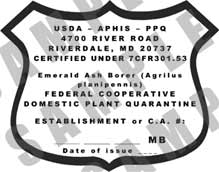NEWS RELEASE — For Immediate Release
Contact: Leigh Greenwood, Don’t Move Firewood campaign manager
LGreenwood@tnc.org
Download PDF version of this press release at https://www.dontmovefirewood.org/resources/Great-Backyard-Bird-Count-2014
BIRD WATCHERS CAN COMBINE GREAT BACKYARD BIRD COUNT WITH A BACKYARD BUG COUNT TO HELP PROTECT TREES AND FORESTS
Looking for signs of insect or disease damage in backyard trees and shrubs during the annual bird count can help preserve vital wildlife habitats.
Arlington, VA—February 7, 2014— Bird watchers participating in the 17th annual Great Backyard Bird Count, February 14 to 17 2014, are encouraged by The Nature Conservancy to look for and report signs of tree pests like the emerald ash borer, Asian longhorned beetle, and other invasive insects and diseases. During the bird count, participants simply watch birds at any location for at least 15 minutes, tally the numbers of each species they see, and report their tallies online. Scientists at The Nature Conservancy want Great Backyard Bird Count participants to know that they should take a few extra moments to look at the birds’ habitats for signs of invasive forest insects and diseases.
“Trees and forests are an essential part of our lives, and they provide clean air and water, jobs and products, and vital wildlife habitat. From tree-lined neighborhood streets to national parks, we count on trees to provide benefits today and for generations to come,” says Bill Toomey, Director of Forest Health Protection for The Nature Conservancy. “That’s why it’s critical for everyone to be aware of the trees around them and take simple actions to help protect them- such as looking for and reporting signs of insects or diseases.”
Many of the forest pests and diseases that affect trees can be stopped or slowed if they are found and treated early enough by the proper authorities. The Nature Conservancy’s Healthy Cities, Healthy Trees program and Don’t Move Firewood campaign, along with many state and federal agencies nationwide, are especially encouraging bird watchers to look for potential signs of forest pests while enjoying the Great Backyard Bird Count this year.
“The Great Backyard Bird Count is an ideal opportunity for bird watchers to check the trees for signs of invasive pests like Asian longhorned beetle and emerald ash borer,” said Jennifer Forman Orth, State Plant Pest Survey Coordinator at the Massachusetts Department of Agricultural Resources. “The damage from these insects can easily be seen in winter, when there are no leaves on the trees, and birdwatchers are typically armed with a pair of binoculars that will help them check high-up branches for the perfectly round holes left by Asian longhorned beetles in maples and other hardwoods, or the increased woodpecker activity and removal of bark (“blonding”) caused by excessive woodpecker activity associated with emerald ash borer infestations in ash trees.”
Birdwatchers can download the new Birdwatcher’s Short Field Guide to Holes in Trees, found at https://www.dontmovefirewood.org/resources/birdwatchers-guide-holes-trees/ to help them learn the differences between holes made by typical woodpecker and sapsucker foraging, holes made by woodpeckers seeking invasive insect larvae, and holes caused by the invasive insects themselves.
Participants in the Great Backyard Bird Count should report any suspicious damage or signs of forest pests as soon as they have concluded entering their bird data. Bird watchers are encouraged to take digital photos of any damage observed, identify the species of tree with the damage if possible, and then report findings using websites, state hotlines, or phone apps such as those found at https://apps.bugwood.org/healthytrees/ .
For more information on regionally and nationally important invasive forest pests, and how to report potential signs of infestation, please refer to the websites below.
###
Download PDF version of Holes in Trees https://www.dontmovefirewood.org/resources/birdwatchers-guide-holes-trees/
Download PDF version of this press release at https://www.dontmovefirewood.org/resources/Great-Backyard-Bird-Count-2014
To learn more about The Nature Conservancy’s Healthy Trees, Healthy Cities program go to https://healthytreeshealthycities.org . To learn more about Don’t Move Firewood, visit https://www.DontMoveFirewood.org .
The Nature Conservancy is a leading conservation organization working around the world to protect ecologically important lands and waters for nature and people. The Conservancy and its more than one million members have been responsible for the protection of more than 18 million acres in the United States and have helped preserve more than 117 million acres in Latin America, the Caribbean, Asia and the Pacific. Visit us on the Web at www.nature.org.





.jpg)
